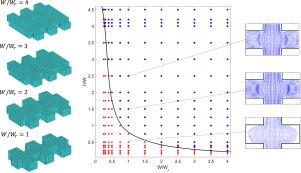Three-dimensional simulation and analysis of the fluid flow in contraction–expansion array microchannels
IF 2.5
3区 工程技术
Q2 MECHANICS
引用次数: 0
Abstract
The primary objective of this work is to investigate the flow characteristics in contraction–expansion array microchannels with a rectangular cross-section. Flow in channels of this geometry is often found in heat exchangers, as a part of functional elements of microfluidic devices applied in medicine, chemical engineering, etc. To achieve such simulations in three-dimensional case a numerical approach based on the Boundary Element Method accelerated both via the Fast Multipole Method, and heterogeneous computing architecture (multicore CPUs and graphics processors) is utilized. We explore numerically the velocity fields formed in the regions of lateral caverns of rectangular shape. Obtained results have been analyzed in detail for different ratios of cavern length and width, as well as their relative location. In addition, a study of the features of secondary flow formation in the regions of microchannel expansion and their changes depending on the variation of the microchannel height has been carried out. The hydrodynamic resistance and flow regimes in microchannels with different hydraulic diameter of the main part and configuration of side caverns were investigated. The obtained results are expected to be significant for selecting and optimizing contraction–expansion microchannel configuration for a wide range of applications.

收缩-膨胀阵列微通道内流体流动的三维模拟与分析
本文的主要目的是研究矩形截面收缩-膨胀阵列微通道的流动特性。作为医学、化工等领域应用的微流体装置功能元件的一部分,在热交换器中经常发现这种几何形状的通道中的流动。为了在三维情况下实现这种模拟,基于边界元方法的数值方法通过快速多极方法和异构计算架构(多核cpu和图形处理器)进行加速。本文用数值方法探讨了矩形侧边洞室区域内形成的速度场。对所得到的结果进行了详细的分析,并对不同的洞室长宽比及其相对位置进行了分析。此外,还研究了微通道扩张区域的二次流形成特征及其随微通道高度变化的变化规律。研究了不同主体水力直径和侧洞型微通道的水动力阻力和流动特性。所得结果对于选择和优化广泛应用的收缩-膨胀微通道配置具有重要意义。
本文章由计算机程序翻译,如有差异,请以英文原文为准。
求助全文
约1分钟内获得全文
求助全文
来源期刊
CiteScore
5.90
自引率
3.80%
发文量
127
审稿时长
58 days
期刊介绍:
The European Journal of Mechanics - B/Fluids publishes papers in all fields of fluid mechanics. Although investigations in well-established areas are within the scope of the journal, recent developments and innovative ideas are particularly welcome. Theoretical, computational and experimental papers are equally welcome. Mathematical methods, be they deterministic or stochastic, analytical or numerical, will be accepted provided they serve to clarify some identifiable problems in fluid mechanics, and provided the significance of results is explained. Similarly, experimental papers must add physical insight in to the understanding of fluid mechanics.

 求助内容:
求助内容: 应助结果提醒方式:
应助结果提醒方式:


